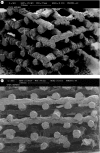Natural origin biodegradable systems in tissue engineering and regenerative medicine: present status and some moving trends
- PMID: 17412675
- PMCID: PMC2396201
- DOI: 10.1098/rsif.2007.0220
Natural origin biodegradable systems in tissue engineering and regenerative medicine: present status and some moving trends
Abstract
The fields of tissue engineering and regenerative medicine aim at promoting the regeneration of tissues or replacing failing or malfunctioning organs, by means of combining a scaffold/support material, adequate cells and bioactive molecules. Different materials have been proposed to be used as both three-dimensional porous scaffolds and hydrogel matrices for distinct tissue engineering strategies. Among them, polymers of natural origin are one of the most attractive options, mainly due to their similarities with the extracellular matrix (ECM), chemical versatility as well as typically good biological performance. In this review, the most studied and promising and recently proposed naturally derived polymers that have been suggested for tissue engineering applications are described. Different classes of such type of polymers and their blends with synthetic polymers are analysed, with special focus on polysaccharides and proteins, the systems that are more inspired by the ECM. The adaptation of conventional methods or non-conventional processing techniques for processing scaffolds from natural origin based polymers is reviewed. The use of particles, membranes and injectable systems from such kind of materials is also overviewed, especially what concerns the present status of the research that should lead towards their final application. Finally, the biological performance of tissue engineering constructs based on natural-based polymers is discussed, using several examples for different clinically relevant applications.
Figures


References
-
- Ang T.H, Sultana F.S.A, Hutmacher D.W, Wong Y.S, Fuh J.Y.H, Mo X.M, Loh H.T, Burdet E, Teoh S.H. Fabrication of 3D chitosan–hydroxyapatite scaffolds using a robotic dispensing system. Mater. Sci. Eng. C. 2002;20:35–42. doi: 10.1016/S0928-4931(02)00010-3. - DOI
Publication types
MeSH terms
Substances
LinkOut - more resources
Full Text Sources
Other Literature Sources

